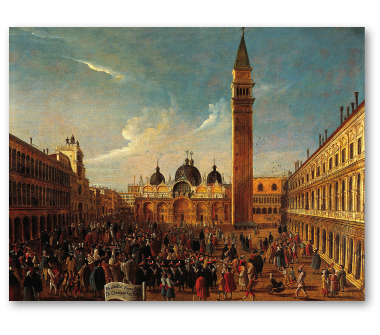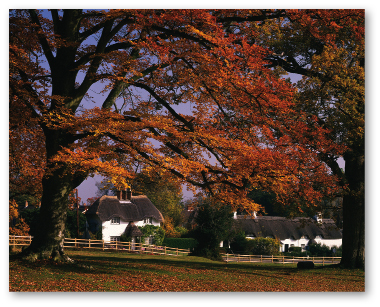Chapter 1
Common Lands for Everyone
For most of its history the original 444 acres known today as the Commons in Niagara-on-the-Lake was officially designated the Fort George Military Reserve at Niagara. This implied that the military had exclusive rights on the property. Nevertheless, as early as 1797 a British officer of the Royal Engineers referred to these lands as “commons”[1] and in the same year local civilians petitioned the government to protect their “Common or Lands now used as such.”[2]

Last Day of Carnival on San Marco Square, Venice, artist Gabriel Bella (1730–1799). Public spaces such as historic and popular St. Mark’s Square in Venice have always been an important element of urban places.
Courtesy of DeAgostini/Superstock Images.
Ever since early human civilizations began to create villages and eventually city-states, public spaces have played an important role in the social fabric of communities. In the cities, formal plazas, piazzas, squares, forums, agoras, campi, places, quadrangles, and esplanades became the multi-functional public gathering sites for markets, fairs, religious celebrations, political rallies, mustering of troops, public punishments including executions, sports events, or just relaxation. In the smaller communities of Britain “the village green” or “the common” usually referred to an unfenced area of grass for all to use, sometimes for grazing of animals but often serving functions similar to that of the city square. Usually the term “commons” implied a plot of public land either within the town or nearby on the edge of the community that was available to all citizens for communal use such as growing crops, pasturing animals, collecting firewood, etc., as well as all other potential uses for such an urban space. Later, public municipal parks and gardens, which first made their appearance in the early nineteenth century, were created to encompass “retreats, recreation and refreshment.”[3] Some social critics decried these urban parks as “the drawing rooms of the poor.”[4] Modern urban planners acknowledge the social importance of these public “people spaces.”
In North America indigenous peoples did not differentiate between individual property and communal territory. However, among Native tribes, spheres of influence were often aggressively maintained.

Swan Green, Hampshire, England, photo. The Open Spaces Society of England and Wales estimates that there are still three thousand village greens/commons in Britain. Quintessential Swan Green with its expansive open spaces and ancient trees is edged by thatched cottages.
Courtesy of Travel Library Limited/SuperStock Images.
England and Wales had a long tradition of open common lands under the Saxons. Conquering Norman kings, however, parcelled up much of England to large landowners and set aside large tracts of ancient woodlands such as the “New Forest” for private deer-hunting grounds. Nevertheless, the ordinary people (commoners) retained certain common rights such as to pasture, to fish (piscary), to collect turf and peat (turbury), and to gather wood (estover). During the Tudor period, the process of “enclosure” was introduced whereby common land was taken into fully private ownership and use. This meant that open arable fields and meadows that had been farmed for generations by poor often landless tenants were transferred to the landed gentry or local lord of the manor who then proceeded to fence in the lands and farm the lands for their own profit. In some locales, common lands were retained, but often in the rough less arable regions. With the rise in food prices “enclosure” escalated such that by the early nineteenth century many former common lands in Britain were enclosed by Acts of Parliament, leaving fewer pasturelands and village greens intact.[5] Some argued that the old subsistence type of farming with its perpetual poverty was grossly inefficient while new agricultural techniques of large-scale private farms were far more productive.[6] Nevertheless, thousands who had lost their centuries-old right were reduced to abject poverty while many landowners became very rich. As witness, a period anonymous protest poem:
They hang the man, and flog the woman,
That steals the goose from off the common;
But let the greater villain loose,
That steals the common from the goose.[7]
John Graves Simcoe, the future Lieutenant Governor of Upper Canada, was the owner of Wolford Lodge in Devonshire. Although he considered himself somewhat of a social reformer, he enforced the enclosure act in his own neighbourhood, citing that improved agricultural practices would ultimately benefit the poor.[8] Later he nearly ended up in a duel over a controversy as to who had the right to collect the dung left by a large number of horses kept on nearby Woodbury Common.[9]
Certainly the other British government officials who accompanied Simcoe to Niagara in 1792 would have been aware of the controversial Enclosure Acts in Britain. Perhaps this explains why none of these officials apparently ever referred to the Military Reserve as common land. It was only after they left for York that the term quickly emerged. Interestingly, Mrs. Simcoe does refer to walking on the “garrison common” at Fort Niagara across the river.[10]
Most of the settlers who came to Upper Canada were from the former Thirteen Colonies where nearly every community had the quintessential village green[11] or common: a large central grassy rectangle surrounded by several protestant churches, the meeting house, the court house, and several impressive homes.[12] This tradition had been transplanted from the pre-enclosure seventeenth-century English villages. The Common Lands of New Harlem on Manhattan Island were created by Colonel Nichols, the first British Governor of New York in 1664. Lexington Green, where the first shots of the American Revolutionary War were fired, remains unchanged today and is still enjoyed by its current citizens. Perhaps most famous is the Boston Common, where on the eve of the American Revolutionary War British soldiers trained beside grazing cows. Nearby was “the Public Garden,” which was supported and enjoyed by the wealthy citizens and begrudgingly open to the public.[13] The Boston Common was, and is, fearlessly protected by the public. In 1917 when the famous neurosurgeon Harvey Cushing was mobilizing the American Medical Corps he insisted on establishing a temporary military camp on the Boston Common. Despite his reputation and patriotic cause he was advised that such an act was a sacrilege and unthinkable — he eventually backed down.[14]
Given this long colonial tradition of village greens and common lands, it is understandable why the recently arrived settlers in Upper Canada would expect a similar public space. As early as 1783 Governor-General Haldimand had produced the “Cataraqui Plan,”[15] which outlined the recommended configuration of the new townships in the colony. This provided for a “common” of four hundred acres “for the use of the town.” However, when the town of Niagara was eventually laid out by surveyor Augustus Jones in 1792, there was still no designation of a commons or true public square. In contrast, in adjacent Township #2 (Stamford), the surveyor Philip Frey had laid out “as much land as a public common to the Township … to amount to 800 acres.”[16] Sometimes referred to as “The Town Farm,”[17] the much reduced “Stamford Green” in the present City of Niagara Falls is a much-appreciated remnant of that vision.
Across the lake at the Sixteen Creek, the town of Oakville was surveyed with a large tract along the lake for “common land.” At York (Toronto) Lieutenant-Governor Simcoe set aside a Military Reserve of one thousand acres on the eastern edge, of which Fort York was established. The adjacent cleared land became known as the “Garrison Common” which was enjoyed by the townspeople. Eventually a “New Fort York” was built on the Reserve one kilometer to the west (later known as Stanley Barracks), but most of the original Reserve eventually became part of Exhibition Grounds on the south, and the “Provincial Lunatic Asylum”[18] to the north. A portion of the original Garrison Common adjacent to Old Fort York survives today surrounded by expressways and tall buildings of the modern metropolis.

The Village Green Covered with Snow, Woodstock, Vermont, photo, Robert Harding. The concept of village greens and commons was transplanted by English colonists to British North America. The Green in Woodstock is the iconic New England public space.
Courtesy of SuperStock Images.
With no designated common lands or village greens in Niagara and a growing population on relatively small town lots it was inevitable that the local citizenry would cast an envious eye on that huge expanse of green arable land plus woodlot beyond. Besides, the soldiers were here to protect the town, not antagonize the loyal citizens of Niagara. Prior to the War of 1812 the Commons did in fact resemble a village green, albeit larger than most. The English Church and cemetery were situated on its eastern edge. Overlooking the grassy commons were the court house and jail (gaol), as well as the Freemasons’ Hall, which acted as a meeting house. Several handsome homes also faced the Commons. Even two hundred years later, with the edges of the original Commons nibbled away, the basic village green/common configuration persists: two churches with their ancient cemeteries can be seen from the Commons, the public school and a day care centre face the Commons, the hospital, a seniors’ apartment, a nursing home, a renowned repertory theatre, a sports complex, and a veterans’ lodge all abut the Commons. Several handsome homes on King and John Streets still overlook the Commons. Most importantly, the remaining 285 acres of grass and trees partially edged by water[19] truly are common lands to be enjoyed by all.[20]